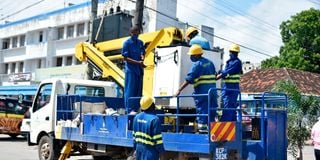Lifted subsidy, tariff review light up Kenya Power forecasts

Kenya Power Company technicians carry out repairs to a power transformer in Mombasa in December 2020.
On Friday, the Energy and Petroleum Regulatory Authority (Epra) published the new electricity charges for September.
In the new schedule, the regulator raised the fuel cost charge (FCC) — the single-biggest variable cost that is adjusted monthly — by a whopping 46.6percent to Sh6.79 per kilowatt-hour (kWh) of electricity up from Sh4.63.
The energy regulator also nearly doubled the Foreign Exchange Fluctuation Adjustment (Ferfa) to Sh1.36 up from 73 cents to cater to the weakening of the Kenyan shilling against the US dollar.
This is the first time Epra has adjusted the FCC and Ferfa rates since December.
The move technically cancelled out a 15 percent cut in electricity prices in January this year on the directive of retired President Uhuru Kenyatta.
The price cut came with deep financial uncertainty for Kenya Power despite a fuel subsidy deal with the State to allow the utility to lower consumer electricity bills without hurting its cash flows. Without subsidy, the 15percent price cuts would translate to a Sh26 billion revenue chop for Kenya Power.
The Treasury this financial year offered Kenya Power a Sh7.05 billion subsidies to allow the utility cut consumer electricity bills by a further 15 percent without hurting its cash flows.
“To shield KPLC from the effects of the electricity price reduction prior to the implementation of this second phase, the company has been allocated Sh7.05 billion in the proposed budget for 2022/23,” the Budget and Appropriations committee revealed in its report to lawmakers in June.
This arrangement was shaky and exposed Kenya Power to cash flow risks given the financial crisis facing the government. The fear was heightened by the billions of shillings owed to oil marketers involved in the fuel subsidy scheme.
With the lifted subsidy scheme it now means that Kenya Power has an opportunity to benefit from the gains of a liberal market system.
“There is more certainty with cash flow because the subsidy schemes have been erratic,” an official of the Energy ministry told Smart Business.
Besides the lifted price caps, Kenya Power stands a chance for a double victory later this year when its long-awaited request for tariff reviews is heard.
The utility firm plans to submit a new tariff application to Epra between October and December as part of a strategy to help it climb out of a financial hole created by the power price cut in January.
Epra has provided for Kenya Power’s new application. It has set aside funds for a conference to discuss the tariff review request.
Official documents show Epra has budgeted Sh495,000 for the meeting which will form part of stakeholder engagement on the matter.
The Energy Act 2019 provides that power tariffs be reviewed every three years although this hasn’t been respected because Epra has often delayed or amended the rates to ease inflation pressure.
The last comprehensive review of electricity prices was in 2019.
The three-year price review is crucial to firms along the country’s power supply chain and involves forecasting electricity demand, generation costs, transmitting, and distributing electricity, and the revenue players need to sustain operations.
In 2019, Kenya Power submitted a plan seeking to increase electricity prices by 20 percent, which would have led to a sharp increase in power costs.
Kenya Power sought to increase the consumption charge for usage of fewer than 100 kilowatts per month to Sh12.50 a unit, up from Sh10.
Consumption above 100 units was to rise to Sh19.53 a unit from Sh15.80.
However, the utility firm withdrew the tariff last year amid sustained pressure by the government for cheaper electricity. It has continuously faulted the delays in approving price increases to collect more revenues.
President William Ruto has vowed to abolish consumption subsidies on items such as petroleum and fertiliser.
Petrol prices last week hit a historic high of Sh179.3 per litre without a subsidy.
Diesel hit Sh165 per litre after an increase of Sh25 per litre from Sh140.03 even as that of kerosene jumped to Sh147.94 per litre, rising by Sh20.
The government applied a partial subsidy of Sh20.82 on diesel per litre and Sh26.25 on kerosene. Diesel is the most consumed fuel product and is heavily used for transport, electricity generation, and agriculture.





